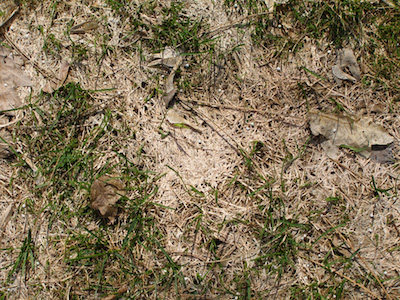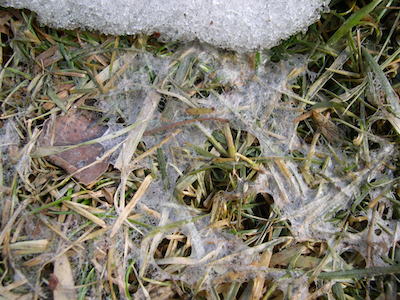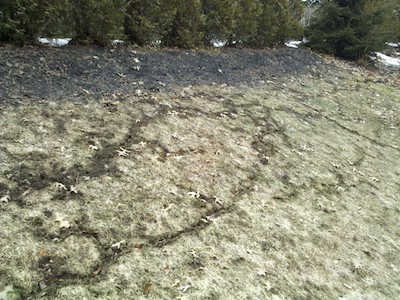Spring Lawn Recovery (What's This Snow Mold?)
Wintertime gives us lawn owners a well-deserved break from mowing, raking, fertilizing, watering, and weeding......but winter, especially one with bitter cold and lots of snow, can leave behind a lawn that looks less than desirable come springtime. Once the snow is gone, a little work and maintenance early on can bring it back as healthy as ever. Even a lawn left covered with the dreaded "snow mold."
Damage Recovery Mode
Here in Michigan, we're recovering from one of the coldest, snowiest winters ever recorded, and all that snow did a real number on our grass lawns.
Many homeowners are watching the snow recede only to leave behind a brown, diseased-looking wasteland which only a few short months ago was a lush greenscape. Even worse, the heavy deep snow that just wouldn't go away has led to a large amount of what is known as "snow mold" covering the lawn.
Now is the time to get outside and start repairing the damage Mother Nature's winter rampage has left behind; truth be told, it's really not that hard to do.
Snow Mold: A Blight Upon the Land
Snow mold leaves the grass lawn looking white with a matted-down appearance. It can also appear as reddish or pink streaks across the matted down dead blades of grass or as a powdery layer over the turf left behind recently-melted snowpack. Snow mold forms when early winter snows and rains leave lots of moisture on the turf, which is then covered with heavy layers of snow. Then, when the snow melts, what is left behind is a not-so-great looking lawn of matted-down, white turf where no healthy grass could ever seemingly grow. Luckily, that's not necessarily the case. While snow mold looks like a death sentence for healthy grass, it's appearance is typically much worse than any actual damage it may do.
What To Do About Snow Mold
While warm-weather lawn fungus may require chemical fungicides to control, snow mold is more easily taken care of. While snow mold looks terrible, the damage it does is actually minimal.
Snow mold will kill the blades of grass, which typically die away anyway due to being covered with snow all winter, but the mold usually doesn't harm the more important root structures of the grass. These healthy, intact roots are what will allow the grass to rebound come spring.
Snow mold seems to happen more with tall-fescue varieties of grass, which are used more and more often on lawns due to their drought resistant properties. We have to take the good with the bad, it seems.
What if you were to do absolutely nothing with your winter-damaged lawn? Would the snow mold take over and kill everything? In a word: No. Leaving snow mold untreated usually just means it will take longer for the lawn to recover its' green lushness. The snow mold and the matted-down layer of turf that it creates forms a less-permeable barrier for water and sunlight to penetrate down to the main grass plant and roots where growth occurs.
The solution to snow mold? All it takes is for you to roll up your sleeves, grab a rake, and get to work! Raking the turk loosens and breaks up the white matted-down material, allowing the warmth of the sun and the spring rains to get down into the soil more easily, resulting in quick green growth. A spring raking also helps prevent thatch buildup, which is a thick layer of dead organic material that forms near the soil level, keeping nutrients away from the roots in the soil. You can bag the raked up material, or mow it over with a mulching mower, which breaks it up into smaller pieces, creating a nutrient-rich food for your soil. This raked-up grass is also a good component for a compost pile.
Breaking up the matted layer of grass in the spring is a great rejuventor for the lawn. Follow this raking up with a springtime application of a natural fertilizer, and even a lawn aeration, and you're on your way to a green lawn that will be the envy of the neighborhood.
Other Possible Winter Lawn Damage
White, matted-down snow mold isn't the only possible damage your lawn may have suffered during the long, hard winter.
Another common problem is vole or mole damage. These little critters leave behind the tunnel-like markings as seen in this photo as they tunnel under the snow and on top of the frozen ground, gobbling up grass. This annoying damage can be repaired by raking and loosening an inch or two of the soil in the damaged area and seeding with new grass seed. Lightly rake the seed into the soil, keep it moist, and you'll have new grass before you know it.
A healthy green lawn is the pride of many homeowners. There are many toxic chemicals, fertilizers, herbicides and fungicides available that promise to keep your lawn green effortlessly, but a lawn can also be kept healthy the natural way without any artificial inputs. This holds true for dealing with winters' wrath of snow mold and vole/mole damage. All it takes is a dedicated homeowner and a little elbow grease.
comments powered by Disqus





































































